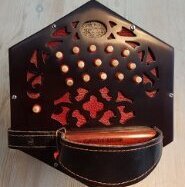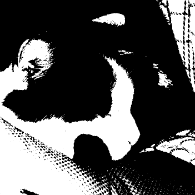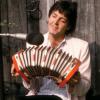-
Posts
486 -
Joined
-
Last visited
About Jake Middleton-Metcalfe
- Birthday 07/14/1990
Contact Methods
-
Website URL
http://www.wolvertonconcertinas.com
Profile Information
-
Gender
Male
-
Interests
Morris dancing, playing music and concertina construction
-
Location
Stony Stratford, Milton Keynes
Recent Profile Visitors
Jake Middleton-Metcalfe's Achievements

Heavyweight Boxer (5/6)
-

Rectangular Wheatstone (?) English on eBay
Jake Middleton-Metcalfe replied to Daniel Hersh's topic in Concertina History
Wow that is all really interesting Gary, thank you for the photos and recordings. I have not seen a baritone English like this before, it's a nice musical range. -

Closing my books
Jake Middleton-Metcalfe replied to Dana Johnson's topic in General Concertina Discussion
Well done on all the hard work and dedication you have and are putting into your work. I have been doing it a bit under 10 years and can see how demanding the job is especially if, like yourself you make your own reeds. It can be quite a demanding lifestyle in it's way, and it's a form of manufacturing which from what I have learned does not always fit easily into the modern manufacturing paradigm... So mostly the maker has to go at it alone. Best wishes from England and enjoy the world outside the workshop, you will have to tell me what that world is like exactly 😂 -

Crook Concertinas
Jake Middleton-Metcalfe replied to gcoover's topic in Instrument Construction & Repair
Gary thank you for sharing this video, I was not aware of what Mr Crook was up to. I met him some years ago and he seemed a good chap. Very interesting to see the ways of dealing with reed making people come up with, that belt sanding setup used to profile the reed is something I never imagined. Its a bit like the Italian way of doing it, but the belt sander they use is at a different angle with the reed flat to the workbench. There are a few videos of Italians making reeds this way on youtube as well. -

How Thick are Metal Ends?
Jake Middleton-Metcalfe replied to Cathasach's topic in Instrument Construction & Repair
I did stainless ends at 0.7 at one point and would not recommend doing it any thinner, as Alex points out the design itself is quite a big factor as well. I would not personally go thinner than 0.7mm using any metal. Looking at older instruments most Lachenal instruments seem to have 0.7mm nickel silver, Jeffries can by anything between 0.7 and 0.91, the thicker 0.91 generally a bit better for the very fine fretwork some Jeffries do have. I once worked on a Wheatstone with 0.6mm ns ends and that was really a bit flimsy in my opinion, with pillars under the hand rest being a necessity. The pillars are quite relevant - on Anglo concertinas especially, they will stop the fretwork flexing if thinner metal is used, the thinner the metal, the more important they are. That is my experience anyway. Good luck with the project, can we see them when they are done? Its always interesting to see peoples work. Best wishes Jake -

Planning a first build- reed question
Jake Middleton-Metcalfe replied to Rayune's topic in Instrument Construction & Repair
The chart stating the prices of various reeds is interesting. Does anyone know which historical manufacturers the harmonicas company copied? Wheatstone? Jeffries? I never asked them I'm just interested though. -

Do you play other instruments?
Jake Middleton-Metcalfe replied to Greg Mirken's topic in General Concertina Discussion
I can play the melodeon and that was my first instrument, honestly I don't really pick the melodeon up anymore I was not dedicated enough to maintain what I would call a competent standard on melodeon and concertina at the same time. I can play tunes on it though. If anyone was living in Hertfordshire in the noughties they may well have seen a teenager with red hair busking with a melodeon, that was me. @Geoffrey Crabb you might have seen me, one of my regular places to play was Bishops Stortford. For years I was at it. -
My local folk club - The Song Loft in Stony Stratford (England) is putting on a concertina music event here are the details: A Feast of Concertina Music -February 16th 2024 In recognition of International Concertina Day (6th February) the Song Loft brings to you four talented concertina players: Jasper Kanachowski, Stephen Ferneyhough and Jake Middleton-Metcalfe. If you want to learn more about concertinas and to hear some top-class performances this is the event for you. Steve Turner will be making a guest appearance and will play some tunes from his 9th album “Curious Times”. Doors Open 7.30pm. Event starts 8.00pm Tickets £11 from https://www.wegottickets.com/event/596607 or £12 on the door. here is a link to the song loft website: https://thesongloft.com/concerts-2021/ for those not familiar with the song loft it is at this address: York house centre, London Rd, Stony Stratford, Milton Keynes MK11 1JQ Perhaps some people on here might enjoy this!
-

Raised ends versus flat ends
Jake Middleton-Metcalfe replied to Snedder's topic in General Concertina Discussion
It's interesting that the frames were actually stamped at the note below what they actually are. It does sound like they stamped the notes before building the tongue or they then tuned the tongue up after it being already made. Anyway it sounds like you have long scale reeds there (all notes made 1 size bigger except the very highest) - and that would explain them sounding with less pressure and being able to play louder, sounds like a great instrument. -

Raised ends versus flat ends
Jake Middleton-Metcalfe replied to Snedder's topic in General Concertina Discussion
good point about the hand rests. Perhaps its more significant in an English where you have no hand rests but still - on its own raising the ends (or indeed lowering the frames which is what is really happening) would be a very small difference in weight. Really the weight saving approach has to be applied to the whole design rather than just the ends if its to be a significant difference. I really have no idea about the differences in sound some people talk about with raised ends, but that is interesting to hear about. -

Raised ends versus flat ends
Jake Middleton-Metcalfe replied to Snedder's topic in General Concertina Discussion
As in there was no or hardly any difference in sound between the wooden or metal ends? I have to say I found the same thing, I made 2 instruments to the same design and tuning one with wooden ends and one with metal and was astonished that it was incredibly hard to tell any difference. At a guess I would say it is probably more to do with the pattern of the fretwork and how large the holes are .. somewhere on here I posted a recording of it but I'm not sure I could find it now










